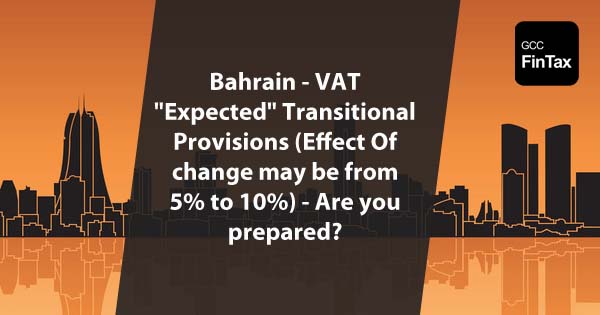
ISSUE OF INVOICE OR RECEIPT OF CONSIDERATION BEFORE THE DATE OF CHANGE (“EXPECTED DUE DATE” (“EDD”))
Under the general VAT rules, in the event of the issue of a tax invoice or receipt of payment by the supplier relating to the supply, the date of supply will be the date of actual supply of the goods or services or the date of receipt of payment (up to the amount received), or the date of issue of the invoice, whichever first occurs.
Under the expected transitional provisions, if a supply of goods or services takes place on or after “Expected Due Date” (“EDD”), any invoice issued for any consideration received before “EDD” may be considered under the 5% tax bracket for the purposes of calculating the time and tax of supply for VAT, and consequently, the supply will be subject to 10% VAT.
If an invoice is issued before “EDD” for a supply that is to be performed after “EDD”, without including the 10% VAT applicable to the goods or services being supplied under that invoice, the supplier must issue an additional invoice specifying the additional amount of (10%-5%) VAT.
VAT may be applied to contracts for the non-continuous supply of goods or services in accordance with the date on which the goods were placed in the possession of the customer, and the special provisions relating to the splitting of the accounting of VAT over the instalments will not apply to such supplies.
If a one-off supply of goods or services is completed before “EDD”, and ownership is transferred before “EDD”, then VAT may be applicable at 5% to any amount due after “EDD”.
In connection with the non-continuous supplies, if delivery of the goods or performance of the services does not take place before “EDD”, VAT may apply at the revised rate i.e. 10% on the full value of the supply on the grounds that the supply has taken place after the revision of VAT rate, and the 10% taxable value will be on value of the goods or services including all instalments or payments paid or due.
The due date for payment of the Revised VAT rate i.e. 10% on the consideration will be the date of actual supply of the goods or services (if after “EDD”). In the event that the supplier has issued an invoice before “EDD” with accounting for VAT at 5% on the supply, he must issue an additional VAT invoice including the differential VAT relating to that supply.
In general VAT law provides that continuous supplies of goods or services that span through “EDD”, may be subjected to revised VAT i.e. 10% on the part of the supply that is performed from “EDD” onwards. VAT may be chargeable at 5% on any part of a continuous supply that is performed before “EDD”. Ensure to arrange for completion certificated or equivalent documents for the conformity of compliance. The supplier must allocate the value of any such supply up to the period before and after “EDD” in the most appropriate way to reflect the goods and services actually provided.
1. Ensure to invoice your completed project within the timelines.
2. In case of continuous contracts, ensure to arrange for completion certificated or equivalent documents for the conformity of compliance.The supplier must allocate the value of any such supply up to the period before and after “EDD” in the most appropriate way to reflect the goods and services actually provided.
3. Revisit your contracts, in case you mentioned 5% VAT (in contracts), there is an immediate need to revisit and incorporate changes.
4. Monitor, your supply, delivery of goods, where applicable and to be completed before “EDD”, and secure effective documentation in hand.
5. Reassess your pricing and business model to be competitive and relevant.
Kindly note: This article is based on expected tax impact, do watch for guidance (from tax authorities) for necessary adoption, however can be a good start for checking compliance.
Disclaimer: Content posted is for informational & knowledge sharing purposes only, and is not intended to be a substitute for professional advice related to tax, finance or accounting. The view/interpretation of the publisher is based on the available Law, guidelines and information. Each reader should take due professional care before you act after reading the contents of that article/post. No warranty whatsoever is made that any of the articles are accurate and is not intended to provide, and should not be relied on for tax or accounting advice.
You can access Law including Guidelines, Cabinet & FTA Decisions, Public Clarifications, Forms, Business Bulletins for all taxes (Vat, Excise, Customs, Corporate Tax, Transfer Pricing) for all GCC Countries in the Law Section of GCC FinTax